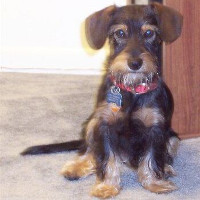Appearance of the Miniature Schnoxie
|
| The Miniature Schnoxie is a small to medium-sized dog, often measuring 25.5 to 35.5 centimeters in height and tipping the scales at 13.5 kilos. For small dogs, the Schnoxie is a breed that can appear to have a very strong, muscular physique. These hybrids will have long muzzles with powerful jaws and ears that tend to sit high on the head, which can be semi-slouchy or completely slouchy. The Schnoxie's body and chest can appear very deep and broad, while the fore and hind limbs are often short but powerful. Schnoxies can either have a straight, smoother coat, or retain a stiffer, rougher coat. Indeed, their parent breed, the Dachshund, can have either a short, smooth, sleek coat, or a dense, stiff coat. So your hybrid's coat will depend on the genes of the dominant parent. |
Temperament of the Miniature Schnoxie
|
| The Miniature Schnoxie is an affectionate, loyal and inquisitive little hybrid that will accompany its owners wherever they go. Because of their pleasant nature, these hybrids can be fairly easy to train. However, some Schnoxies can be quite stubborn and willful. They will need a firm owner who will set boundaries and house rules. Schnoxies can be excellent companions for families with children and other pets, but it's never a good idea to leave a dog unsupervised with another animal or child. When meeting a stranger, your Schnoxie may bark and be very cautious. Schnoxies don't have aggressive voices; their barking is intended to warn their owners. However, as these pooches can be quite vocal, they may not be suited to an apartment or city lifestyle. |
Needs and activities of the Miniature Schnoxie
|
| The Miniature Schnoxie is not an overly active dog and won't require huge amounts of exercise. On average, owners should walk their Schnoxie 2-3 times a day for at least 30-40 minutes. Your Schnoxie can benefit from activities such as retrieving, short runs, long walks, hiking and agility classes. These hybrids are social butterflies and will thrive in an environment where they can interact and play with other dogs. Although Miniature Schnoxies don't require much exercise, it's important never to neglect your hybrid, as it can develop anxiety and obesity. |
Maintenance of the Miniature Schnoxie
|
| The Miniature Schnoxie is an average maintenance dog when it comes to grooming. The Miniature Schnoxie's coat may not be as thick as that of the Schnauzer. If this is the case, owners can simply brush their hybrids every few weeks to distribute the oils and keep their coats shiny. Schnoxies can be prone to doggy odors, so if you have a hybrid that smells a little off, you can wash it once a month with a mild shampoo. The Schnoxie is a low shedding dog that can be hypoallergenic if it retains a more Schnauzer-like coat, and may be suitable for owners who don't like to see loose hair around their home. Like all dogs, the Schnoxie is prone to dental disease, so it's crucial that owners brush their hybrid's teeth weekly to prevent bacterial infections and tooth decay. Also, as the Schnoxie tends to have floppy ears, it's important to keep these ears clean and free from excessive dirt, as excess wax production can lead to yeast infection. |










 English (United Kingdom)
English (United Kingdom)